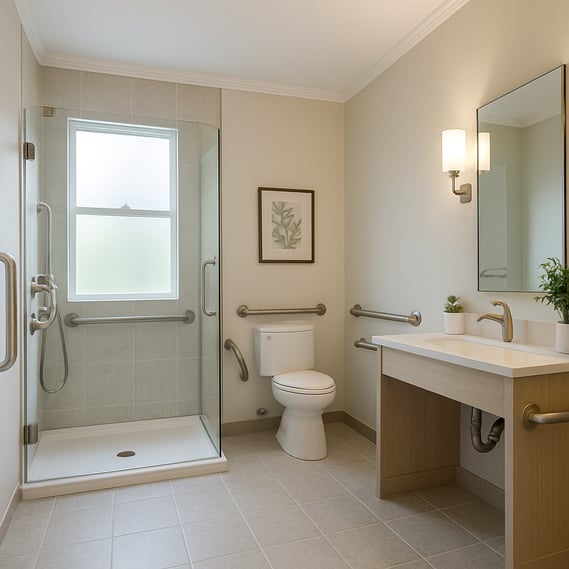Let’s face it — accessible homes are something everyone will need at some point in life. Whether for ourselves, a family member, or a guest, accessibility enhances safety, comfort, and independence for all.
The need for home modifications isn’t driven by age—it’s shaped by life’s experiences. Any household living with a disability among its members can benefit from additional accessibility features that make everyday living smoother and safer.

Starting with ADA Guidelines
Except in extreme situations, complete ADA compliance isn’t required for private home remodeling. Still, the Americans with Disabilities Act (ADA) provides a great foundation for accessible design.
The ADA’s measurements for clearances, ramp slopes, and grab bar placement create safe benchmarks to follow, even if you don’t need to meet every technical requirement. Remember, ADA standards are designed for public spaces and may not perfectly fit individual needs or body sizes.
When working on a private residence, you have the flexibility to adapt the best of ADA guidance while customizing it to your household’s specific mobility and lifestyle needs.
A Short History of the ADA
In the 1960s, disability advocates began to push for equal rights, paving the way for the Americans with Disabilities Act, officially signed into law in 1990.
This groundbreaking legislation ensured equal access for people with disabilities across workplaces, transportation, and public accommodations. Over time, accessibility concerns expanded from physical barriers to include digital access — a vital step in today’s connected world.
The ADA continues to evolve, ensuring inclusion for people of all abilities in both physical and digital environments.
Disability and Design: The Human Connection
Disability isn’t defined only by physical impairments — it’s the interaction between a person’s abilities, their daily activities, and the design of their surroundings.
Language and understanding have evolved, too. Outdated terms like “handicapped” have been replaced with “physically challenged” or “person with a disability.” Each individual experiences limitations differently, which is why universal design—creating homes that work for everyone—is essential.
No matter your age, it’s important to regularly evaluate your home to ensure it meets your current and future needs. Life events such as childbirth, illness, injury, or caring for an aging parent can all prompt accessibility updates that keep your home safe and functional.
These same design principles form the foundation of Aging in Place, the practice of staying in your own home comfortably and independently for as long as possible.
Why Work with a CAPS Professional?
When accessibility challenges arise, homeowners often don’t know where to begin. That’s where Certified Aging in Place Specialists (CAPS) come in.
Developed by the National Association of Home Builders (NAHB) and AARP, the CAPS program trains professionals to design and remodel homes that meet the needs of people of all ages and abilities. CAPS-certified experts understand both the technical construction requirements and the personal considerations of adapting a home for safety and independence.
You can find qualified CAPS professionals across the country at nahb.org/CAPS.
Meet Austin’s Local CAPS Expert
David L. Traut, CAPS, owner of T-Square Company in Austin, Texas, is one of this elite group of specialists. With more than 30 years of experience, David helps homeowners remodel and design homes that support independent living for every stage of life.
T-Square Company provides complete home assessments with designs and full-service Aging in Place remodeling, including:
-
Custom bathroom and kitchen modifications
-
Barrier-free showers and grab bar installations
-
Accessible entryways and widened doorways
-
Whole-home alterations for increasing comfort, accessibility, independence, and safety
Call T-Square Company at 512-444-0097 to begin your next chapter of safe, accessible living — without leaving the comfort of your home.
CAPS #1636580
Learn More: “Age in Place at Home”
As an extension of his work, David has authored Age in Place at Home: Adapting the Home Environment for All Generations, now available on Amazon.
This comprehensive guide draws on over 30 years of experience and explains how to use Universal Design principles to make every room more livable. Whether you’re planning ahead or adapting for current needs, this book offers insights, ideas, and practical steps for keeping your home accessible for life--your forever home.









